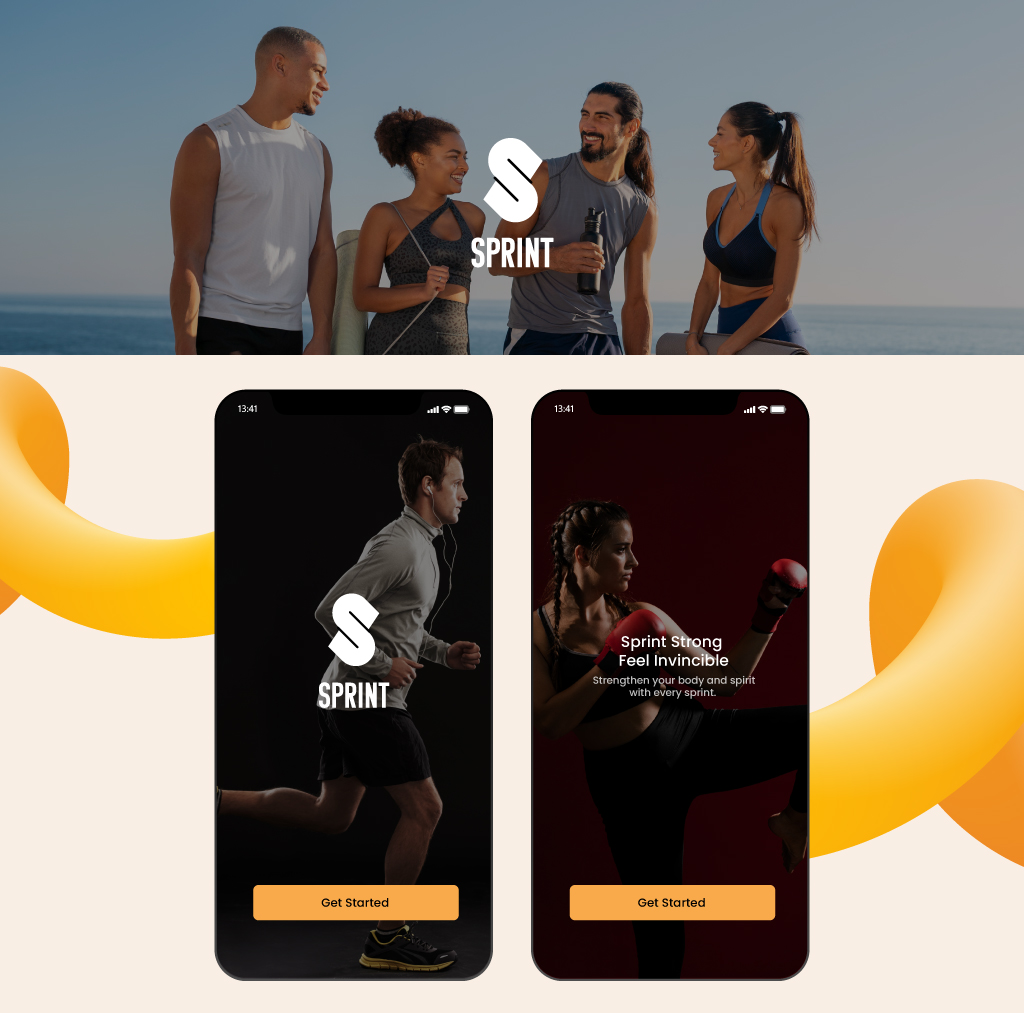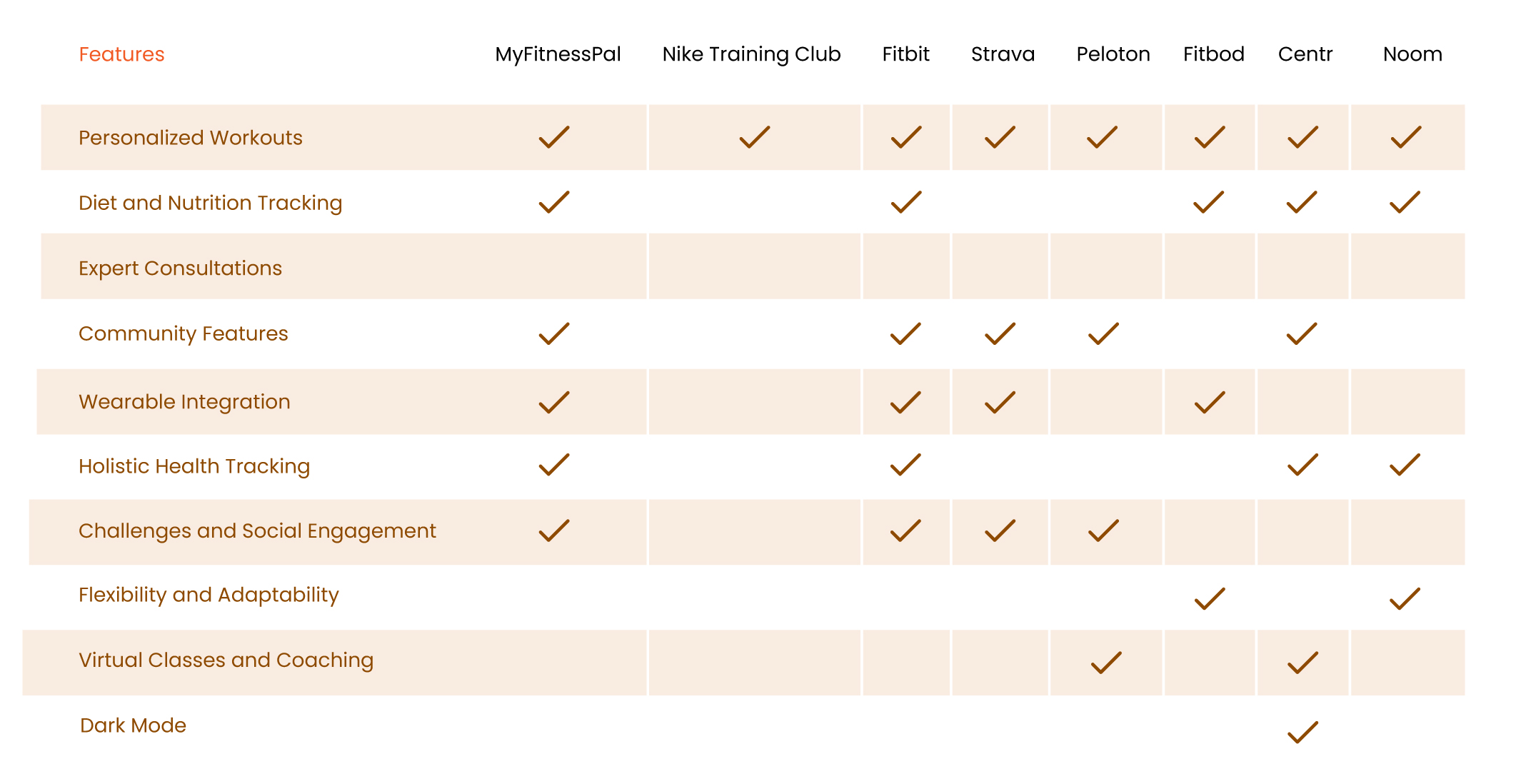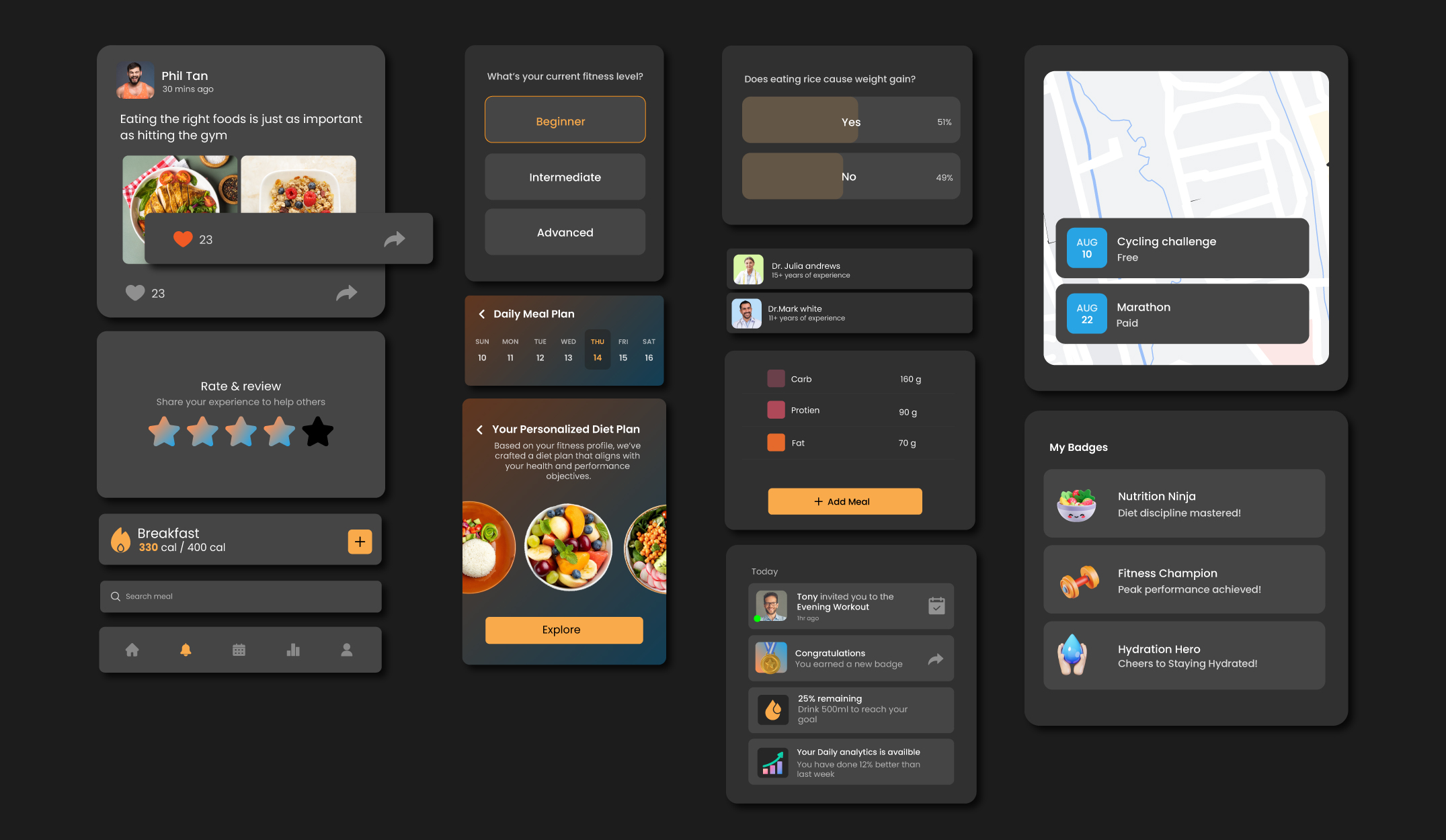Sprint: Discover the New You!
My Role: Ideation & Conceptualization | Wireframing & Prototyping | Design Handoff | Cross Functional Collaboration | Iteration & enhancements
Sprint is a cutting-edge mobile app designed to bridge the gap between fitness enthusiasts and a network of local trainers, nutritionists, and wellness coaches. Sprint aims to provide a comprehensive platform for personalized fitness and health management.


Sprint empowers users to achieve their fitness goals by offering a holistic and integrated approach to health and wellness, all within a supportive and engaging platform.

Problem Statement:
Fitness enthusiasts struggle to find a single, cohesive platform that offers personalized workout plans, nutrition guidance, and easy access to local experts while maintaining flexibility and adapting to their evolving needs

Design Process
The design process for Sprint began with a clear vision: to create an integrated fitness app that connects users with local fitness experts and offers personalized, adaptable fitness and nutrition plans. From initial concept development and market research to the creation of user personas and journey mapping, every stage was meticulously planned to address the real needs of fitness enthusiasts. Through iterative design and rigorous testing, Sprint evolved into a user-friendly platform that provides a holistic approach to fitness and health management, culminating in a polished MVP ready to empower users on their fitness journeys.


Competitor Analaysis
In the competitive landscape of fitness apps, Sprint faced significant challenges and opportunities. Established players like MyFitnessPal, Fitbit, Nike Training Club, and Peloton dominated with their specialized features—ranging from comprehensive diet tracking and seamless integration with wearables to immersive workout experiences and community-driven challenges. Despite their strengths, these apps often fell short of delivering a holistic fitness solution that integrated personalized workout routines, nutrition guidance, and easy access to local experts in a single, cohesive platform. This created a niche for Sprint to capitalize on the unmet need for an all-encompassing app that offers not only robust fitness and nutrition tracking but also facilitates connections with personal trainers, nutritionists, and other fitness professionals, addressing both convenience and comprehensive health management in one unified experience.

Exisiting Issues and Challenges
This analysis identified key areas where the old design fell short in meeting user expectations and functionality demands. By pinpointing specific pain points, such as cumbersome navigation, inconsistent user interfaces, and inadequate feature sets, this section shed light on the critical elements that necessitated a redesign

User Persona
Understanding our diverse user base was crucial for crafting a fitness app that met the varied needs and expectations of fitness enthusiasts. Sprint catered to individuals from different walks of life, each with unique fitness goals and challenges. Our user personas—Emily, the Busy Professional; Mike, the Fitness Enthusiast; Sarah, the New Mom; and Alex, the Senior Fitness Seeker—illustrated the broad spectrum of users we aimed to serve.


User Journey Map
This detailed user journey map outlined the actions, touchpoints, emotions, pain points, and opportunities at each stage and served as a strategic tool to guide design and development decisions.
| Stages | Awareness | Acquisition | Onboarding | Engagement | Habit Formation | Mastery | Advocacy | Feedback |
|---|---|---|---|---|---|---|---|---|
| User Action | Learns about the Sprint app through social media, online ads, or word of mouth | Downloads the app and registers an account | Completes the onboarding process, including setting fitness goals and preferences | Begins using the app daily to track workouts, diet, and progress | Incorporates the app into daily routine, relies on it for workout plans, tracking, and motivation | Utilizes advanced features of the app, customizes further settings, perhaps subscribes to premium services | Recommends the app to friends and family, leaves positive reviews | Provides feedback through surveys, support interactions, or app reviews. |
| Touchpoints | Social media posts, Google ads, referrals from friends | App Store/Google Play, registration form on the app | Onboarding screens, goal setting, preference selection | Dashboard, workout logs, meal planner, progress tracker | Daily notifications, reminders, community interactions | Settings, subscription page, advanced training modules | Social media, review platforms | Feedback forms, customer support, app review sections |
| Emotions | Curiosity, interest | Anticipation, excitement | Engagement, motivation | Determination, satisfaction | Dependence, routine | Mastery, pride | Loyalty, advocacy | Valued, heard |
| Pain Points | Lack of effective targeting and visibility in ads; low engagement on social media | Complicated onbarding process | Overwhelming amount of information; lack of clear guidance during setup | Cluttered interface, inconsistent feedback on progress, lack of customization options | Notifications can be intrusive or poorly timed; community features are underdeveloped | Advanced features can be difficult to navigate | Lack of incentives to share or recommend the app | Feedback mechanisms are hard to find and use, slow response to user inquiries |
| Opportunities | Improve ad targeting, enhance social media engagement through interactive and engaging content. | Streamline the registration process; optimize app performance | Simplify onboarding steps, provide clear and concise instructions, use engaging tutorials | Redesign user interface for clarity, introduce personalized feedback and more customization options | Optimize notification settings for user preference, enhance community interaction with more social features | mprove navigation within the app, clearly highlight the benefits of premium features with tutorials or demos | Implement referral programs and rewards, make user reviews more prominent and accessible on platforms | Make feedback channels more visible and easier to use, ensure timely responses to user feedback to improve satisfaction |
Wireframes
The wireframing process for Sprint involved creating clear, simplified visual guides to map out the app’s layout and functionality. Initially, detailed descriptions for each screen were established, focusing on user interaction and intuitive navigation. These descriptions guided the development of wireframes, which serve as the blueprint for the app’s design and user experience. Each wireframe was designed to align with Sprint’s primary goals: to offer a user-friendly interface for tracking fitness, connecting with trainers, and accessing personalized health insights.

Design System
The design system for Sprint established a comprehensive set of guidelines, components, and visual elements to ensure consistency and coherence across the app. It served as the foundation for building a cohesive user interface, promoting a seamless and engaging experience for users. This overview outlined the key components and principles that make up the design system, which was tailored to meet the specific needs of fitness enthusiasts and maintain brand identity.



Onboarding
We ensured the onboarding experience to be intuitive, engaging, and highly personalized. The process begins with a warm welcome screen, setting the tone with our commitment to transforming users’ fitness journeys. We then guide users through a seamless flow where they provide essential personal details such as age, height, and weight, followed by specifying their fitness goals. This allows us to tailor workout plans and dietary recommendations precisely to their needs.


Final Mockups and designs
The final mockups and designs for Sprint translate the app’s conceptual wireframes into polished visual representations, capturing the essence of the brand and enhancing user engagement. These detailed mockups incorporate refined aesthetics, interactive elements, and accessibility considerations to create an intuitive and visually appealing fitness app experience. Here’s an overview of the key aspects of the final designs:
Analytics
The Analytics section in Sprint provides users with a comprehensive view of their fitness progress through intuitive, data-driven insights. It features dynamic charts and graphs that visualize key metrics such as workout frequency, step counts, caloric intake, and hydration levels. Users can easily track their performance over time with interactive progress indicators and goal-tracking visuals.

Notifications and Events
Notifications provide timely updates on workout reminders, goal achievements, community interactions, and personalized fitness tips, ensuring users stay engaged and motivated. Events highlight upcoming fitness activities, local training sessions, and virtual challenges, offering opportunities to connect with fellow enthusiasts and participate in diverse fitness experiences.

Profile & Premium Access
The Profile area displays detailed user information, including achievements, fitness statistics, and connections with trainers or friends. Users can customize their experience, track their progress, and update their personal settings. The Subscription segment offers insights into premium benefits, such as advanced analytics, personalized coaching, and exclusive workout plans. Subscribers can easily view and manage their subscription status, unlocking enhanced features that provide a more tailored and enriched fitness experience.

Network & Community
It empowers users to build their network by following friends, trainers, and nutritionists, and joining groups centered around shared fitness interests. Users can participate in community discussions, share achievements, and collaborate on fitness challenges, creating a supportive environment that promotes motivation and accountability.

Daily Tasks
The Daily Tasks section of the Sprint app is ingeniously designed to keep users engaged and organized with their fitness routines and health goals. This dynamic feature allows users to meticulously schedule their day with various activities such as workouts, nutritional consultations, and personalized diet plans. It acts as a digital planner where each task can be set with specific times and reminders, ensuring that users stay on track with their fitness objectives


Pilot Study
The pilot program proved crucial in making final adjustments to the Sprint app, ensuring that the redesign met the high standards expected by users. The detailed feedback and data gathered helped the development team prioritize changes and improvements, paving the way for a successful full-scale launch.

Conclusion
The Sprint fitness app stands out as a comprehensive platform designed to enhance every aspect of a user’s fitness journey. The design process, guided by user-centered principles, ensures that each feature is not only functional but also aesthetically pleasing and easy to use. By integrating feedback and continuously iterating, Sprint has developed an app that is both engaging and effective in helping users achieve their fitness goals. The result is a holistic fitness app that seamlessly combines data-driven insights, personal empowerment, and community support, offering a dynamic and enriching experience for every user.
